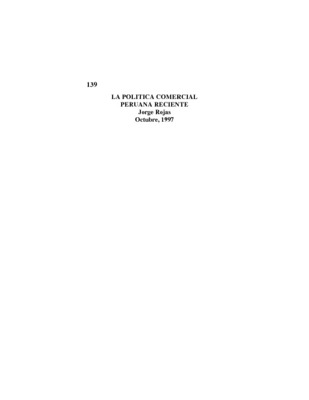| dc.contributor.author | Rojas, Jorge | |
| dc.date.accessioned | 2015-03-17T16:11:16Z | |
| dc.date.available | 2015-03-17T16:11:16Z | |
| dc.date.issued | 1997 | |
| dc.identifier.uri | http://repositorio.pucp.edu.pe/index/handle/123456789/46779 | |
| dc.description.abstract | Luego de hacer una muy breve revisión de las políticas llevadas a cabo entre 1960 y 1990, este trabajo busca revisar la política de liberalización comercial y cambiaria llevada a cabo en el Perú entre 1990 y 1997, para luego tratar de evaluar sus resultados.En lo concerniente a la liberalización comercial, se destaca el hecho de que mientras la tarifa nominal promedio cayó fuertemente entre 1990 y 1997, la recaudación arancelaria como porcentaje del valor de las importaciones apenas se vio afectada, contraste que se explica por la eliminación simultánea de las restricciones cuantitativas y de las rebajas arancelarias. Por el lado de las exportaciones, se destaca la eliminación de los impuestos a las exportaciones tradicionales, así como la supresión del subsidio a las exportaciones no tradicionales (Certex), y su reemplazo por una variedad de instrumentos (drawback, admisión temporal y zonas francas industriales). El resultado más importante de la liberalización comercial ha sido pasar de un superávit comercial de US$1,200 millones en 1980 a un déficit de US$2,000 en 1996.Por otro lado, la abolición de los controles cambiarios facilitó el retorno de capitales fugados durante los 70’s y 80’s y la captura de una mayor porción de los ingresos del narcotráfico, lo cual aunado al ingreso de capitales extranjeros, han configurado una suerte de “enfermedad holandesa” que ha mantenido deprimido el tipo de cambio real.Se argumenta también que las fricciones entre el gobierno peruano y el Grupo Andino resultaron más del desproporcionado déficit comercial con los países andinos, y de la preocupación del gobierno peruano por proteger sus ingresos fiscales, que de su vocación neoliberal que lo llevaba a rechazar un AEC escalonado. Se subraya la importancia del comercio peruano con sus socios andinos, especialmente por el importante mercado que estos países constituyen para las exportaciones no tradicionales peruanas.Finalmente, se discuten los factores que explican la vitalidad del programa económico actual, dados los importantes desbalances en los que se ha incurrido desde 1990, entre los que están, entre otros, el retorno de capitales fugados, el ingreso de capitales por la privatización de las empresas públicas, y la válvula de escape que para el mercado laboral representa la importante emigración de mano de obra al extranjero. | es_ES |
| dc.description.abstract | After reviewing the policies of the 1960-1990 period, this paper attempts to survey the commercial and exchange liberalization policies carried out by the Peruvian government between 1990 and 1997, trying thereafter to appraise the consequences of these policies.With regards to commercial liberalization, it is underscored that while the average nominal tariff fell sharply between 1990 and 1997, tariff revenues as a percentage of total imports were hardly affected, situation that is explained by the simultaneous elimination of quantitative restrictions and tariff rebates. On the side of exports, taxes on traditional exports were abolished, and the same fate suffered the subsidy to non-traditional exports (Certex), which was replaced by a variety of instruments (drawback, temporal admission, and industrial tax-free areas). The main outcome of commercial liberalization has been to go from a trade surplus of US$1,200 million in 1989 to a deficit of US$2,000 in 1996.On the other hand, the elimination of exchange controls allowed for the return of private capital that flew from the country during the 70’s and 80’s, and the capture of a bigger portion of the revenue of drug traffickers which, together with the inflow of foreign capital, have given rise to some kind of Dutch Disease, with the consequent effects on the real exchange rate.It is also argued that the disputes between the Peruvian government and the Andean Group were more the result of a disproportionate trade deficit with the Andean countries, and of a Peruvian government concerned with protecting its revenues, and less the product of a neoliberal predisposition that induced it to oppose a non-flat Common External Tariff. The importance of the Peruvian trade with its Andean partners is underscored showing that those countries constitute a very important market for Peruvian non-traditional exports.Finally, the factors that explain the vitality of current economic program, in spite of the large unbalances that have occurred since 1990, are discussed, underlining, among others, the importance of the reversal of capital flight starting in 1990, the inflow of foreign capitals associated to the privatization of public enterprises, and the big relief that the emigration of labor meant for the domestic labor market. | en_US |
| dc.language.iso | spa | es_ES |
| dc.publisher | Pontificia Universidad Católica del Perú. Departamento de Economía | es_ES |
| dc.relation.ispartofseries | Documento de Trabajo;139 | es_ES |
| dc.rights | info:eu-repo/semantics/openAccess | es_ES |
| dc.rights.uri | http://creativecommons.org/licenses/by-nc-nd/2.5/pe/ | * |
| dc.subject | Proteccionismo--Perú--1960-1976 | es_ES |
| dc.title | La política comercial peruana reciente | es_ES |
| dc.title.alternative | Recent Peruvian commercial policy. | en_US |
| dc.type | info:eu-repo/semantics/workingPaper | |
| dc.type.other | Documento de trabajo | |
| dc.subject.ocde | http://purl.org/pe-repo/ocde/ford#5.02.00 | |
| dc.publisher.country | PE | |
| renati.advisor.orcid | https://orcid.org/0000-0003-1956-0983 | |


